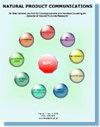通过多指标方法评估清热解毒颗粒缓解肾病综合征的作用机制
IF 1.5
4区 医学
Q4 CHEMISTRY, MEDICINAL
引用次数: 0
摘要
目的 本研究以阿霉素(ADR)诱导的肾病综合征(NS)大鼠模型为研究对象,通过代谢组学和转录组学评估青雷卡生颗粒(QRKSG)的疗效和作用机制。方法 模型组、贝那普利组和 QRKSG 组大鼠经尾静脉注射 6.5 mg/kg ADR。未处理组接受等量生理盐水注射。建模一周后开始灌胃给药。贝那普利组大鼠的贝那普利剂量为 0.9 mg/kg/d,QRKSG 组大鼠的 QRKSG 剂量为 1.62 g/kg/d。灌胃期间,每周收集 24 小时尿液。灌胃四周后,将大鼠麻醉,收集血清、粪便和肾脏样本。通过检测24小时尿液中的蛋白质和血清生化指标,以及肾脏样本的组织病理学观察、TUNEL检测和Western Blot,评估QRKSG对NS的保护作用。此外,对肾脏代谢物进行气相色谱-质谱(GC-MS)代谢组学测序有助于研究 QRKSG 产生的显著差异代谢物,这些代谢物与改善 NS 大鼠肾脏的病理损伤有关。随后,通过转录组测序分析研究了 QRKSG 对药物作用产生影响的重要靶点。同时还研究了两组靶标之间的相关性。此外,还研究了 QRKSG 对 NS 大鼠肠道微生物群的影响。结果表明,QRKSG 对 NS 大鼠具有显著的肾脏保护作用,能逆转异常的尿蛋白含量和血清生化紊乱,并改善肾脏病理损伤。根据进一步的多组学研究,多个基因和代谢物在 QRKSG 给药后被反调控。代谢组学和转录组学的综合分析表明,QRKSG主要通过调节氨基酸代谢途径来缓解NS。肠道微生物群分析表明,QRKSG可通过改善肠道微生物群来缓解NS。分子对接结果表明,QRKSG活性成分与核心靶点有良好的结合能力,其中对接效果最好的成分主要是黄酮类和酚酸类成分。通过TUNEL检测和Western Blot分析验证了代谢组学和转录组学的联合研究结果。QRKSG减轻NS症状的机制是通过对炎症、氧化应激、能量平衡和细胞凋亡的多成分、多靶点和多途径治疗调节。此外,QRKSG 还可以通过调节肠道微生物群来缓解 NS。本文章由计算机程序翻译,如有差异,请以英文原文为准。
Mechanism of Action of Qingrekasen Granules in Alleviating Nephrotic Syndrome Evaluated by a Multi-Omics Approach
ObjectivesIn this study, the efficacy of and mechanism of Qingrekasen Granules (QRKSG) is evaluated by metabolomics and transcriptomics using adriamycin (ADR)-induced nephrotic syndrome (NS) in rat model.MethodsThe model, benazepril, and QRKSG group received a single injection of 6.5 mg/kg ADR via the tail vein of the rats. The untreated group received an equal saline injection. The administration of drugs by gavage began after completing the modeling for one week. Benazepril was given at 0.9 mg/kg/d to the benazepril group and QRKSG was given at 1.62 g/kg/d to the QRKSG group. During gavage, 24 h urine was collected weekly. After four weeks of gavage, rats were anesthetized, and we collected the serum, feces, and kidney samples. The protective effect of QRKSG on NS was assessed by the detection of proteins in the urine at 24 h and serum biochemical indexes, as well as histopathological observation, TUNEL assay, and Western Blot of kidney samples. Moreover, gas chromatography-mass spectrometry (GC-MS) metabolomics sequencing of kidney metabolites helped investigate the significant differential metabolites produced by QRKSG that are implicated in ameliorating the pathological damage to the kidneys of NS rats. Subsequently, the significant targets of QRKSG that had an impact on the action of drugs were investigated by a transcriptome sequencing analysis. The correlation between both sets was also investigated. In addition, the effect of QRKSG on the gut microbiota of NS rats was investigated. Finally, the core targets were validated by molecular docking.ResultsThe results indicated that QRKSG possess significant renoprotective effects in NS rats by reversing the abnormal urinary protein content and serum biochemical disorders, as well as improving renal pathological damage. Multiple genes and metabolites were shown to be back-regulated after QRKSG delivery, based on further multi-omics studies. The integrated metabolomics and transcriptomics analysis showed that QRKSG alleviated NS mainly by regulating amino acid metabolic pathways. Gut microbiota analysis demonstrated that QRKSG could alleviate NS by improving gut microbiota. The molecular docking results showed good binding ability of the QRKSG active ingredient to the core target, and among them, the ingredients with the best docking effect were mainly flavonoids and phenolic acid ingredients. The combined metabolomics and transcriptomics study findings were validated through a TUNEL assay and a Western Blot analysis.ConclusionWe have concluded that ADR-induced NS in rats can be treated with QRKSG. The mechanisms used by QRKSG to reduce the symptoms of NS are through the multi-component, multi-target, and multi-pathway therapeutic modulation of inflammation, oxidative stress, energy homeostasis, and apoptosis. Additionally, QRKSG could alleviate NS by regulating gut microbiota.
求助全文
通过发布文献求助,成功后即可免费获取论文全文。
去求助
来源期刊

Natural Product Communications
工程技术-食品科技
CiteScore
3.10
自引率
11.10%
发文量
254
审稿时长
2.7 months
期刊介绍:
Natural Product Communications is a peer reviewed, open access journal studying all aspects of natural products, including isolation, characterization, spectroscopic properties, biological activities, synthesis, structure-activity, biotransformation, biosynthesis, tissue culture and fermentation. It covers the full breadth of chemistry, biochemistry, biotechnology, pharmacology, and chemical ecology of natural products.
Natural Product Communications is a peer reviewed, open access journal studying all aspects of natural products, including isolation, characterization, spectroscopic properties, biological activities, synthesis, structure-activity, biotransformation, biosynthesis, tissue culture and fermentation. It covers the full breadth of chemistry, biochemistry, biotechnology, pharmacology, and chemical ecology of natural products.
Natural Product Communications is a peer reviewed, open access journal studying all aspects of natural products, including isolation, characterization, spectroscopic properties, biological activities, synthesis, structure-activity, biotransformation, biosynthesis, tissue culture and fermentation. It covers the full breadth of chemistry, biochemistry, biotechnology, pharmacology, and chemical ecology of natural products.
 求助内容:
求助内容: 应助结果提醒方式:
应助结果提醒方式:


